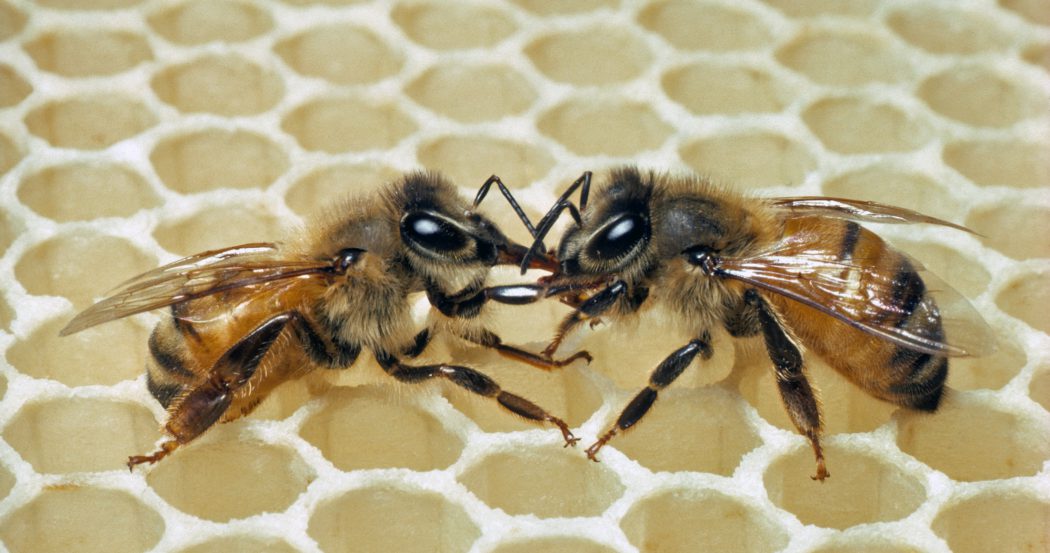A Call for Help!
By: Thomas D. Seeley
For many years, I kept on the hillside above my little house outside Ithaca, New York, a special hive of bees. This hive was mounted on a platform scale of the sort that is normally used for weighing heavy packages. I visited this hive close to dark every evening from April to October, to weigh it and see how much food (nectar and pollen) the bees living inside this hive had collected that day. On many days, flowers yielding nectar and pollen were scarce, so this scale-hive colony gathered little food and I recorded in my notebook a weight gain of just a few ounces, or maybe even a weight loss. But on some days—such as during the explosion of dandelion flowers in May, the flowering of basswood trees in July and the profusion of goldenrod flowers in September—I recorded weight gains of several pounds. Most of these big weight gains marked strong collection of nectar. On one remarkable day in September 1992, for example, my scale-hive colony had amazing success… it took in more than 27 pounds of goldenrod nectar! I estimate that when ripened into honey, the bees’ gain from this one day’s labor was about 11 pounds of honey, which is enough to fill 15 plastic squeeze bears. Days like this tell us that a colony of honey bees must cope with booms and busts in its intake of nectar. This article describes a nifty communication behavior that helps a colony do so… the tremble dance.
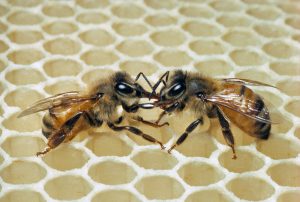
Fig 1. A nectar storer (left) has inserted her tongue between the mouthparts of a nectar collector (right). The storer bee is imbibing the nectar that the collector bee is regurgitating from the full “honey stomach” in her swollen abdomen. Photo by Kenneth Lorenzen
The acquisition of nectar involves two distinct groups of bees: (1) the bees that work outside the hive collecting nectar and (2) the bees that work inside processing nectar (Fig. 1). The members of the first group, the nectar-forager bees, are among the oldest bees in a colony while the members of the second group, the nectar-storer bees, come from the ranks of a colony’s middle-aged bees. These two groups interact in the unloading area just inside the hive entrance. This is where the nectar foragers pass off their fresh nectar to the nectar storers (Fig. 2). These bees either distribute the nectar to hungry nestmates or they store it in the honey combs for future consumption.
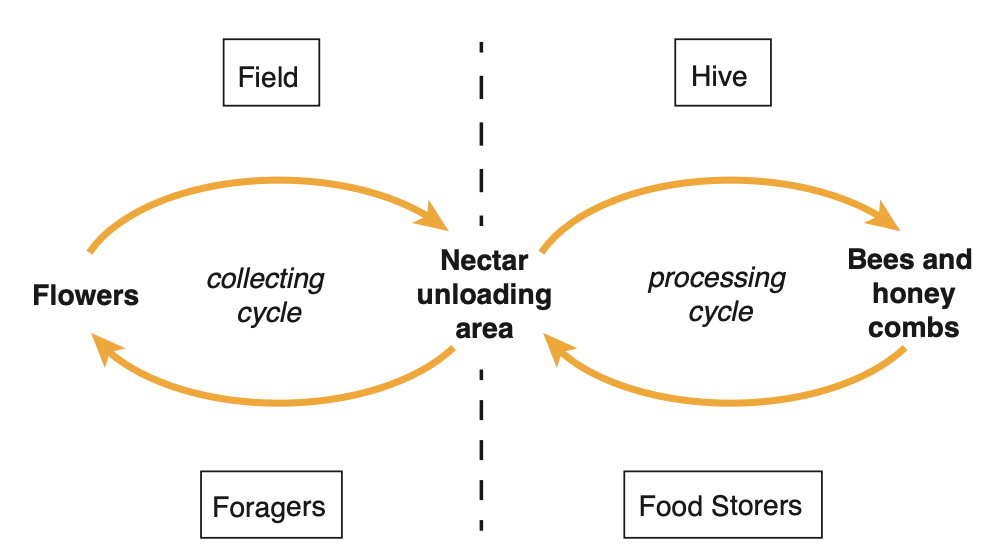
Fig 2. The division of labor between nectar foragers and nectar stores in honey bee colonies.
The specialization by worker bees on different parts of the overall task of nectar acquisition—nectar collecting and nectar processing—boosts the efficiency of a colony’s honey making. It means, for example, that when a forager has located a patch of flowers laden with nectar, she can concentrate on exploiting these flowers before they fade, competitors arrive,or darkness falls, rather than spreading her efforts between collecting work and processing work.
At the same time, however, this division of labor creates a problem of work coordination within a colony. The rates of nectar collecting and nectar processing must be kept in balance for the overall operation of nectar acquisition to proceed smoothly. If the collecting rate exceeds the processing rate, then nectar foragers will experience delays in unloading upon return to the hive. Reciprocally, if the processing rate—or more precisely, the processing capacity—exceeds the collecting rate, then the nectar storers will experience delays in finding nectar foragers who need to be unloaded. Such problems of coordination associated with division of labor are not limited to honey bee colonies. They arise in human factories as well, since the efficiency of any multistage production process depends critically upon the absence of bottlenecks in the flow of items from one stage of the process to the next.
Some years ago, as part of my studies of the organization of nectar collection by honey bee colonies, I discovered that honey bees have a special communication signal that is produced by nectar foragers and is sent to potential nectar storers, and that helps a colony to keep its rates of nectar collecting and nectar processing well matched. This discovery was an especially sweet one because it also solved a long-standing mystery that had been raised in the 1920s by the Austrian zoologist and Nobel laureate, Karl von Frisch.
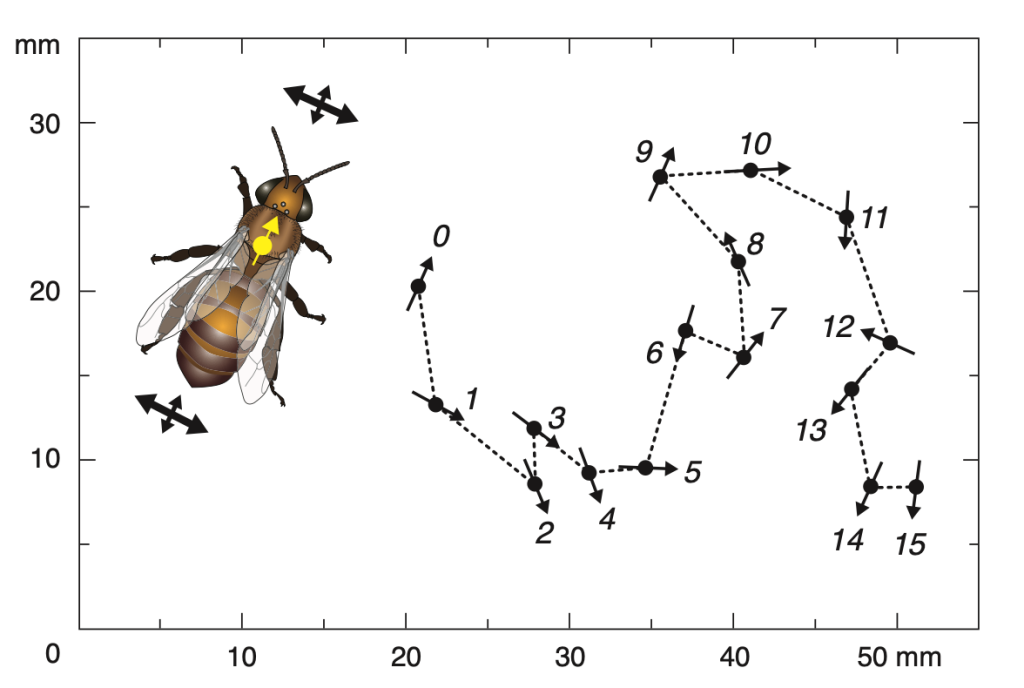
Fig 3. A 15-second record of a worker bee’s behavior while she performed the tremble dance. Drawing on left illustrates the striking, side-to-side trembles of her body. Track on right shows how this bee walked slowly across a comb and rotated her body by about 30 degrees every second or so. Scale: 50mm = 2 inches
In 1923, von Frisch published his first major report on the communication dances of honey bees. In this report, he described not only the famous waggle dance, by which foragers inform one another of the locations of rich food sources, but also a dance that he called the tremble dance (in German, der Zittertanz) (Fig. 3). My translation of his description of the tremble dance reads as follows:
At times one sees a strange behavior by bees who have returned home from a sugar water feeder or other goal. It is as if they had suddenly acquired the disease St. Vitus’s dance [chorea]. While they run about the combs in an irregular manner and with a slow tempo, their bodies, as a result of quivering movements of the legs, constantly make trembling movements forward and backward, and right and left. During this process they move about on four legs, with the forelegs, themselves trembling and shaking, held aloft approximately in the position in which a begging dog holds its forepaws. If they have brought home sugar water… often [they] will retain it until they have quieted down. The duration of this “tremble dance” is quite variable. I have seen instances where the phenomenon has died away after three to four minutes, then the bee appeared normal again and flew out of the hive. Usually, however, this dance lasts much longer and three times I have observed a bee tremble on the combs without interruption for three quarters of an hour.
The message of the tremble dance was a mystery to von Frisch, for although it seemed to be a communication signal, he was unable to identify its cause or detect any effect on other bees in the hive, despite having observed more than 60 bees perform this behavior. This led him to the tentative conclusion that the tremble dance gives the other bees no information. Some 40 years later, in his masterwork on the bees’ dances (von Frisch, 1967), he repeated this conclusion: “I think it [the tremble dance] tells the other bees nothing.” He noted that several other investigators had reported that tremble dances seemed to be the result of foragers experiencing adverse circumstances outside the hive—such as a marked deterioration of their food source—and he suggested that the tremble dance might be an incidental effect of a “nervous conflict” in these bees.
In 1987, I began to see that von Frisch’s conclusions about the tremble dance might be mistaken. I realized that this dance might play an important role in the organization of a colony’s foraging for nectar. My suspicions about this arose from some surprising results of an experiment that I performed with a colony living in an observation hive. When I removed most of the nectar storers from this colony and then observed the effects of this “surgery” on the colony’, I saw—as expected—that the nectar foragers had to search noticeably longer than usual to find nectar storers to get unloaded upon return to the hive. Their search times jumped from about 10 seconds to nearly 50 seconds. But, I also saw—to my surprise—that soon after the nectar foragers entered my observation hive and had difficulty finding nectar storers, they performed tremble dances. Wow! Furthermore, I saw that after about two hours, by which time the colony’s nectar foragers no longer needed to conduct lengthy searches to find nectar storers, the nectar foragers stopped performing tremble dances. It was clear that, somehow, the colony had replaced the nectar-storer bees that I had removed.
These serendipitous findings led me to form a two-part hypothesis regarding the tremble dance: first, its cause is nectar foragers experiencing long searches to find nectar storers; and second, its effect is to stimulate additional members of the colony to function as nectar storers. In other words, I proposed that the tremble dance serves to remove a bottleneck in the nectar acquisition process at the start of a honey flow by signaling a need for more workers to function as nectar-storer bees.
Four years later, in the Summer of 1991, I undertook an experiment designed to test my hypothesis. I moved a colony living in an observation hive to the Cranberry Lake Biological Station (CLBS), which is located in the Adirondack State Park, in northern New York. I took my study colony to this site because it is surrounded by nearly unbroken forests and lakes, so it is a place with very few flowers. Indeed, no honey bee colonies live around the CLBS, except those that I bring to it for my experiments. Here I can easily control the rate at which a colony’s nectar foragers bring nectar (sugar water) into their hive, because their only significant sources of food are the sugar-water feeders that I provide. And with the help of assistants tending the feeders, I can control the number of bees foraging at my feeders.
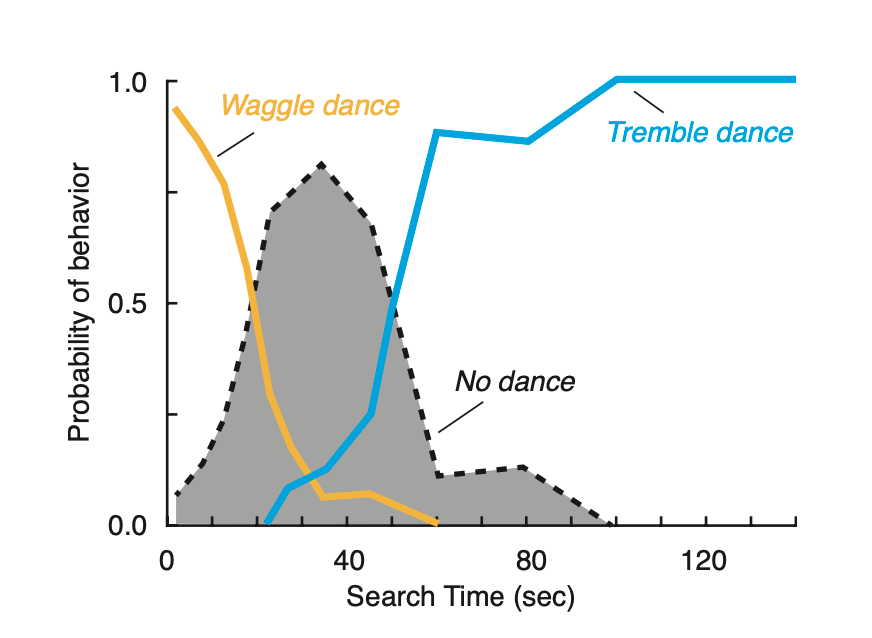
Fig 4. Dance behavior as a function of the in-hive search time for foragers that have visited a rich nectar source. Search times shorter than 20 seconds were followed by waggle dances, and search times longer than 50 seconds were followed by tremble dances.
To test my hypothesis about the cause of the tremble dance, I provided a colony living in an observation hive with two sugar-water feeders and I regulated the rate at which “nectar”-laden foragers returned to this hive by controlling the total number of bees visiting my two feeders. When this number was low (only 30 bees total), the forager bees quickly found nectar-storer bees (in just 10 seconds, on average) when they got home. And virtually all of the forager bees performed waggle dances. But when the number of bees visiting my two feeders was high (120 foragers total), these bees had difficulty finding nectar-storer bees (on average, each forager searched 45 seconds). And these forager bees no longer performed waggle dances; instead, they performed tremble dances! Overall, I saw that if a nectar forager located a nectar storer within 20 seconds of entering the hive, then she performed a waggle dance, but if she had to search for 40 seconds or more to find a nectar storer, then she performed a tremble dance (Fig. 4).
To test my hypothesis about the effect of the tremble dance, I again regulated the rate at which nectar foragers returned to the hive, but this time I counted the number of bees functioning as nectar storers on days with low and high levels of nectar-forager traffic, i.e., on days without and with tremble dancing. To count the nectar storers in my study colony, I replaced the glass on one side of my observation hive with a stiff nylon mesh (i.e., tulle, the material used to make tutus for ballet dancers) and then I daubed paint on the back of each bee that I saw unloading nectar from a forager. The effect of tremble dancing soon became clear. For example, on July 19, 1994 when the traffic level of nectar foragers was low (just three bees per minute entering the hive) and no tremble dances were performed, I labeled only 550 bees functioning as nectar storers. But on the next day, when the traffic level of nectar foragers was high (more than 25 bees per minute entering the hive) and more than 15 tremble dances were performed simultaneously within the hive, I labeled more than 1500 bees functioning as nectar storers.
These studies of the tremble dance deepened our appreciation of the complexity of the inner workings of a honey bee colony, especially of the bees’ social organization for making honey. We have long admired how foragers can share information about rich food sources by means of the waggle dance. We now understand that the effectiveness of the waggle dance in boosting a colony’s rate of nectar intake can create a problem for the bees, that of having too few nectar storers to handle the unloading needs of an enlarged group of nectar foragers. And we now understand that this problem is solved by means of a second dance produced by nectar foragers when they experience excessive delays in unloading—the tremble dance. Maybe there is even a lesson here for us. Perhaps our banks, grocery stores, and other places where customers must wait to be served should adopt a communication system like the bees’ tremble dance so that when long waiting lines develop the customers can call for additional tellers, cashiers, and the like, rather than just wait and quietly hope that more will soon appear.
Tom Seeley is a retired professor in the Department of Neurobiology and Behavior at Cornell University. This article is adapted from a chapter in his forthcoming book Piping Hot Bees and Boisterous Buzz Runners. 20 Mysteries of Honey Bee Behavior Solved. Princeton University Press.






